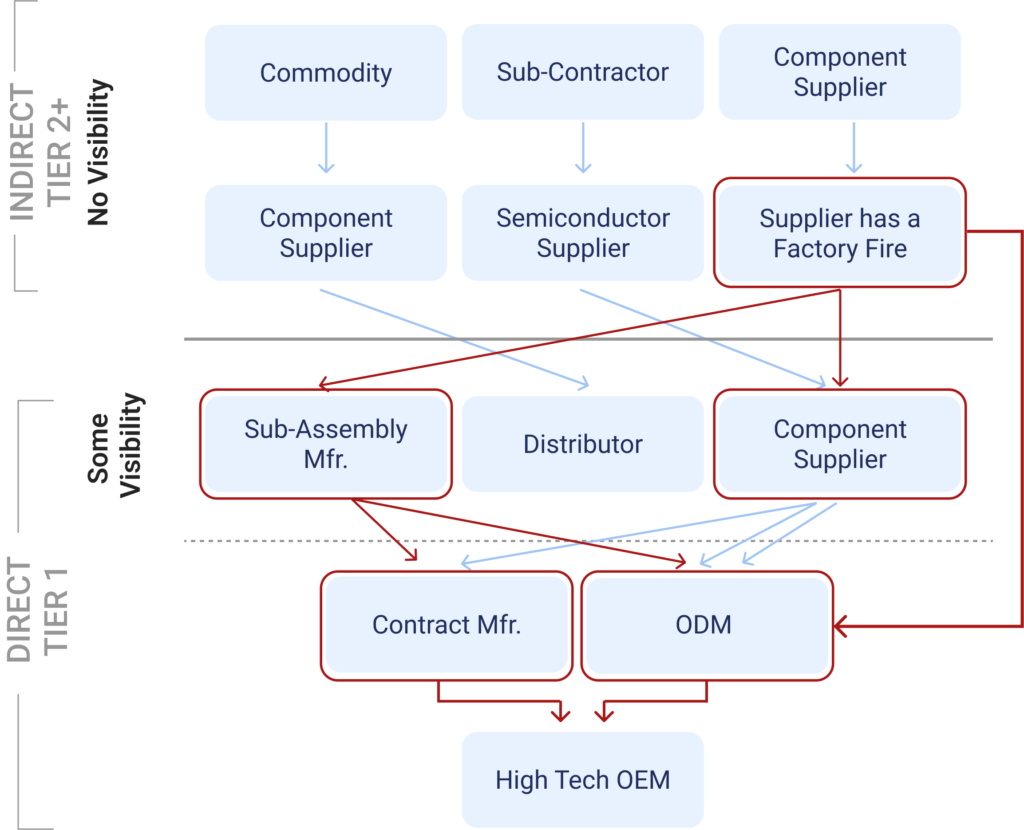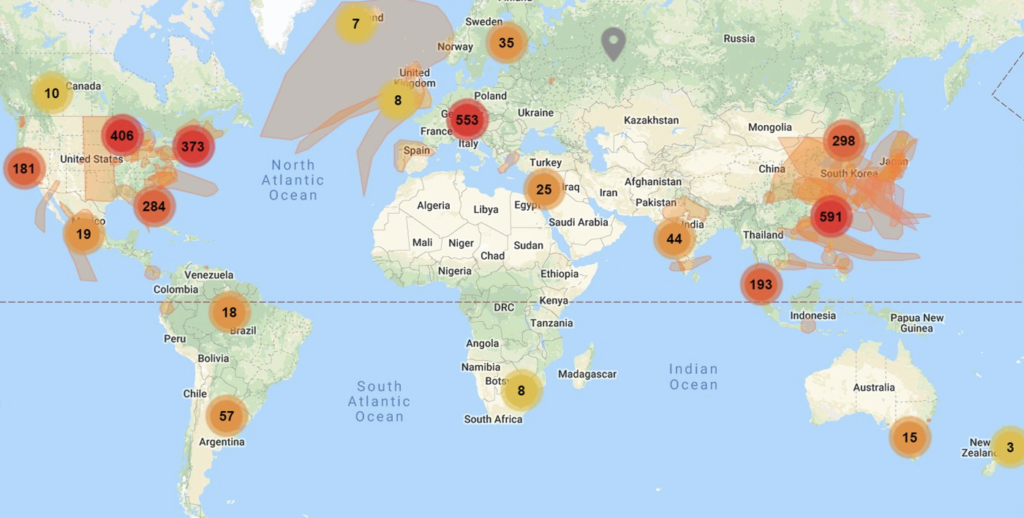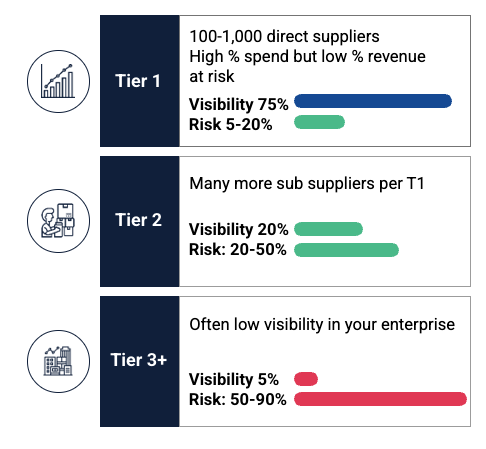So, you’ve been given the responsibility of your company’s supply chain risk and resiliency program. Where to start? A comprehensive risk management program begins with data — mapping data to be specific. As you do research, it’s likely you’ll find different options are available, and you may wonder…
- Is AI mapping the best solution for mapping my supply chain?
- How accurate is AI mapping and what features are most important?
- What about validated multi-tier supply chain mapping?
- What is the best mapping solution for ESG compliance?
In this blog we’ll answer your burning questions about supply chain mapping. First, we’ll cover why mapping is crucial to supply chain resiliency. Then we’ll look at the differences between two major types of supply chain mapping: Multi-Tier Mapping and Autonomous AI Mapping. Finally, we’ll explore the pros and cons so you can make an informed decision about how you map (and manage) your supply chain!
***
What is supply chain mapping?
Supply chain mapping is the process of collecting information and data about your entire supplier network, ideally down to the part-site level; then, using that data to achieve multi-tier visibility of your supply chain. Mapping can be done with AI or through the more manual process of supplier validation and collaboration.
Why is supply chain mapping important?
Most companies do not have a good understanding of who their suppliers’ suppliers are or where their global sub-contractors are located. This is risky considering 85% of disruptions occur in the indirect (tier-2+) supply chain. To get this necessary visibility, companies must map their supply chains.
Once you have mapped your supplier network, you will have a complete picture of your entire supply chain. This kind of visibility enables quick decision making when disruption occurs, or in some cases, before the disruption has happened.
Let’s look at an example.
Imagine a hurricane is approaching an area where you manufacture important parts that go into your products. How can you act quickly? Do you know all your supplier sites in that location? Mapping down to the site level will give you the visibility you need to make timely decisions such as advancing orders, moving inventory, or shifting sourcing to another location before the storm impacts production!
What are other benefits of supply chain mapping?
Covid-19 serves as a good example of what can happen when supply chain mapping is invested in: as the pandemic ramped up, companies that had mapped their supply networks down to the second- and third-tier levels could quickly see a complete picture of how the evolving crisis would affect their supply chains in the weeks or months to come. This identification of specific areas of failure helped companies take action before the disruption hit.
Looking forward, as increasing ESG legislation takes effect across the globe such as UFLPA and the German Supply Chain act, it is now more important than ever to have clear visibility into your supply chain. Legislation like this requires businesses to know where their products come from and validate that products are ethically made; knowing your suppliers through mapping is the key to avoiding violations.
Want to learn more? Check out Resilinc’s webinar: Supply Chain Mapping: Why it Matters.
***
Now that you know what supply chain mapping is and why it’s important, let’s look at the two different types of mapping: AI Mapping and Multi-Tier Mapping.
***
What is AI supply chain mapping?
AI (or autonomous) mapping uses artificial intelligence to collect information on your “most likely” suppliers. This information can come from various sources such as websites and public domain sources. Many companies offer AI supply chain mapping — so what makes each offering unique?
The amount and quality of data collected.
As an example, Resilinc’s AI mapping encompasses over a decade of supplier intelligence harnessed from public domain sources. This includes billions of records analyzed using our powerful AI web scanning system for part-level and site-level insights. We’ve also done product teardowns to get to most accurate parts and suppliers used three tiers deep in the chain. Resilinc then applies multiple analytic techniques to clean, de-duplicate, and normalize noisy data into structure and accurate insights.
Pros and Cons of AI Mapping
| Pros | Cons |
|
|
AI supply chain mapping is a great way to rapidly (and inexpensively) gain visibility into your supply chain. However, AI often comes with a surplus of irrelevant data. For example, if one of your suppliers is 3M—the AI will search for all of 3M’s factories and suppliers. Then, the AI will assume all of 3M’s suppliers are also your suppliers.
As you can imagine, this is often too broad of a scope to be useful. Odds are, you do not work with all of 3M’s suppliers. You may only work with a handful in one region, or perhaps 3M only produces one small part for your product. While AI supply chain mapping is inexpensive and quick to implement, the data is not always verified.
AI supply chain mapping is great for getting a snapshot of your supply chain, but for that data to be most useful, you need to verify your suppliers. Multi-Tier supply chain mapping lets you do just that.
What is Multi-Tier Mapping?
Multi-tier supply chain mapping is the process of verifying suppliers at different levels (or tiers) throughout your supply chain. Unlike AI mapping, Multi-Tier Mapping involves supplier-validated data — giving you a significantly more accurate picture of your supply chain. As an example, Resilinc has been collecting supplier-validated mapping data for over 12 years (and chances are your suppliers are already mapped in our network).
The deeper you go in the supply chain, the lower the visibility: this is what multi-tier mapping fixes. Ideally, you should at least map your supply chain down to third-tier suppliers, as 85% of disruptions originate in the indirect (Tier 2+) supply chain — where many businesses do not have visibility. Side note: for some industries, Resilinc has even mapped down to 5th or 6th tier suppliers! Below is an example of what multi-tier mapping looks like:

Typical visibility across supply chain tiers
The supply chain tiers will look different for each business — but generally most businesses have the highest visibility in Tier-1. This is where your direct suppliers and distributors live. These suppliers typically occupy a high percentage of spend, but a low percentage of revenue.
Tier-2 houses more sub-suppliers and is lower visibility for most businesses, and Tier-3 and beyond is where 50-90% of your supply chain risk comes from. These tiers would typically have the lowest visibility. Keep in mind, these are the suppliers that are likely low spend, but may be producing raw materials or items that are essential to the final product. So, a disruption here could ultimately cause lines to go down if your organization isn’t aware of it. Below is a look at the visibility vs risk for each supply chain tier.
We touched on some of the advantages of multi-tier supply chain mapping, but let’s take a closer look at the pros and cons.
Pros and Cons of Multi-Tier Mapping
| Pros | Cons |
|
|
Visibility is key to supply chain resiliency! Unfortunately, getting that visibility can be time consuming. Does your business have the time it takes to individually reach out to each of your suppliers and maintain contact with them? If the process seems daunting, you may be quick to rule out multi-tier mapping and opt for AI mapping instead. Thankfully, Resilinc makes multi-tier mapping an accessible option for any business.
With Resilinc’s Multi-Tier Mapping solution, you’ll get deep supply chain visibility down to the part-site level. Unlike others, our Multi-Tier Mapping approach is comprehensive and powered by 12 years of supplier-validated data. This includes:
- 800K validated suppliers
- 1M validated sites
- 4M validated parts
- 100K commodities
With this type of sub-tier visibility, you can pinpoint and collaborate with your suppliers within hours of a disruption. Our Multi-Tier Mapping solution enables proactive mitigation strategies that enable you to recover swiftly; reducing freight expedites, preventing lines down, and optimizing your working capital. Since your suppliers are validated, you can quickly and easily prove due diligence for ESG violations!
The Power of AI Combined with Multi-Tier Mapping

AI mapping is a quick way to map your most likely supply chain (and for new ESG legislation like the UFLPA, it’s a smart choice), but for a true picture of your actual supplier network, validation is the next step. We highly recommend a hybrid approach to optimize for speed and coverage! When you combine AI mapping and multi-tier mapping, you cover the pros and cons of each — and build a more resilient supply chain.
Want to learn more about which mapping solutions are right for you? Get in touch with Resilinc to discuss your unique supply chain!







